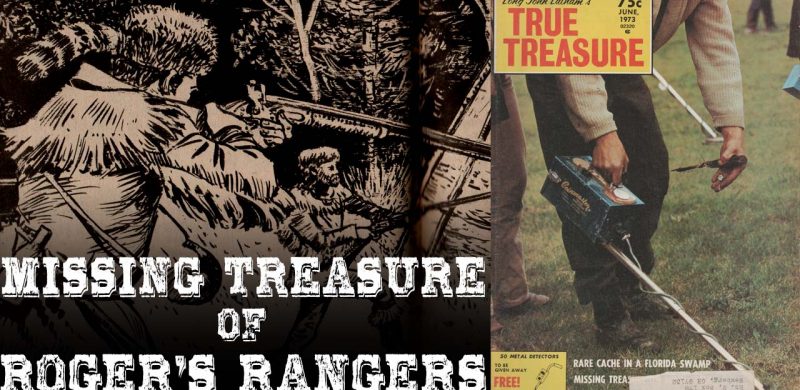
Lost Silver Madonna of the White Hills
This story is a simplified summary of Howard Duffy’s article ‘Lost Silver Madonna of the White Hills’, from the June 1973 issue of the magazine Long John Latham’s True Treasure.
In the fall of 1759, Major Robert Rogers launched a reprisal attack against the Indian village of St. Francis, unknowingly setting in motion a mystery that has intrigued treasure hunters for over two hundred years. The mystery revolves around the loss of a silver statue of the Madonna in the White Hills of New England. Although the statue is not particularly valuable in terms of its monetary worth, it holds immense sentimental and historical value. The story of the silver Madonna began during the French and Indian War when the conflict between the French Canadians and British colonists was at its peak. Lord Jeffrey Amherst, the commander of the British forces, summoned Major Rogers to lead an expedition to the Indian village of St. Francis in Quebec. Rogers and his rangers, who had established themselves as exceptional wood fighters, were well-suited for the mission. However, their lack of discipline and occasional insubordination posed a challenge to Rogers. Despite these challenges, Rogers was able to secure a higher base pay for his rangers than that of British regulars.
As the sun set on Crown Point, Major Robert Rogers and his band of 200 rangers began their perilous journey to St. Francis. They moved swiftly, their buckskin clothing blending into the dark forest as they carried their weapons, ready for battle. With no fanfare or drums, they embarked on a 300-mile journey, navigating treacherous terrain and avoiding detection by the enemy.
Their journey began on the calm waters of Lake Champlain, where they rowed in whaleboats under the cover of darkness. They successfully evaded French patrols and hid their boats on the northern shore. But their victory was short-lived as the French soon discovered their boats and the mission was compromised. The question on everyone’s mind: where would the attack take place? The stakes were high, but Rogers and his rangers were determined to succeed in their quest for glory and redemption.
The journey through the dense forests, swamps, and mountains was a treacherous one for Major Robert Rogers and his rangers. After 22 days of arduous travel, they finally halted near the Indian village of St. Francis. Under the veil of darkness, Rogers and his scouts moved forward, catching the unsuspecting Indians off-guard. The village was unprepared for the sudden attack, and the rangers showed no mercy as they sought revenge for past Indian attacks on their settlements. The wigwams and chapel were set ablaze, and the rangers looted the shrine, taking the gold chalice, candlesticks, cross, and silver statue of the Virgin. But a curse was uttered by a dying Indian, warning of the Great Spirit’s wrath against the accursed palefaces.
As the Abenaki’s curse echoed through the burning chapel, even the bravest of Robert Rogers’ rangers quivered at the thought of what was to come. Suddenly, the chapel’s bell began to toll, its chimes slow and ominous. The men listened in wonder and dread until the bell finally crashed into the flames with a mournful clang. This was the turning point of their good fortune.
Rogers quickly ordered his men to march southward, but their retreat was cut short by a swarm of angry French soldiers and Indian warriors. With no other option, Rogers split his forces, one group heading south and the other eastward towards the Connecticut River. Many were caught and killed by their pursuers, but a small group carrying a silver statue of the Madonna managed to make their way to the river.
Famine and winter quickly set in, reducing the group to just four emaciated soldiers, led by Sergeant Amos Parsons. Though they were tempted to throw away the statue, they persisted, clinging to it as a symbol of their hope and survival.
As the rangers trudged through the rugged wilderness, their bodies weakened by hunger and cold, one of the group claimed to know the land and led them through the treacherous Great Notch of the White Hills. Struggling to survive, the rangers even resorted to eating their cartouche box leather. Eventually, they found shelter in a rocky overhang near the Israel River. But one ranger, driven mad by the Abenaki curse, seized the silver Madonna and threw it off a nearby precipice.
Years later, woodsmen discovered the remains of the group, but the Madonna remained lost. That is, until an ancient party of treasure hunters consulted a fortune teller in the White Hills. She used her magical stone to predict the stars would align to reveal the location of the silver statue. With hope renewed, the treasure hunters set out to find the Madonna and unlock its secrets.
The adventurers followed the old woman up the treacherous mountain to a spot marked by her magic. She pointed to the ground and commanded the men to dig. As the storm raged around them, the men worked tirelessly until they were overcome by fear and fled down the mountain. Rumors began to circulate that the old fortune teller, consumed by greed, continued to dig in the darkness. A blue flame appeared, illuminating the rocks, and a monstrous figure emerged from the storm, hurling the woman off the cliff. Local legends tell of eerie wailing near the site of the hunt, and some believe the hag still resides in a dark cavern. Though the silver Madonna was carried by Rogers’ band, the treasure remains undiscovered. But can anyone overcome the curse of the Abenaki?

1 Comment
SEPTEMBER 13, 1864
THE LEGEND, according to Dobie: Ed Adams lost his fortune in GOLD when his prospecting party was attacked by Apaches. Howdy-Nocona Fowler cracked this cold case; find out what REALLY happened through Howdy’s SOLID RESEARCH that took six years. Howdy’s new 2024-published book, Adams Lost Gold is now available on Amazon.com. Search Amazon, Books, then Howdy-Nocona Fowler, then Adams Lost Gold. Go get it! The truth is much more gruesome than the Legend of Adams Lost Gold.